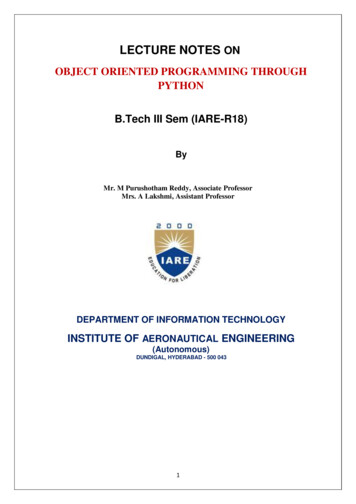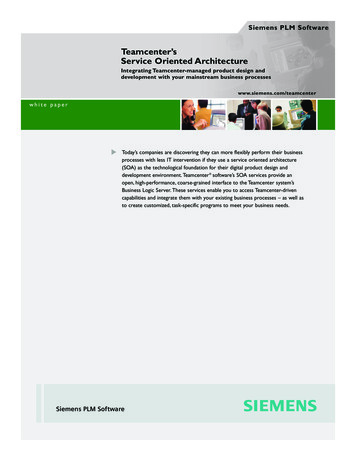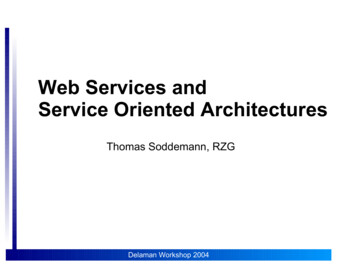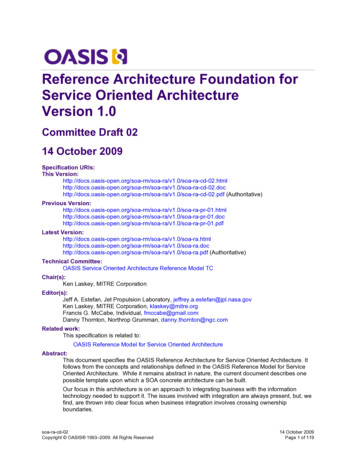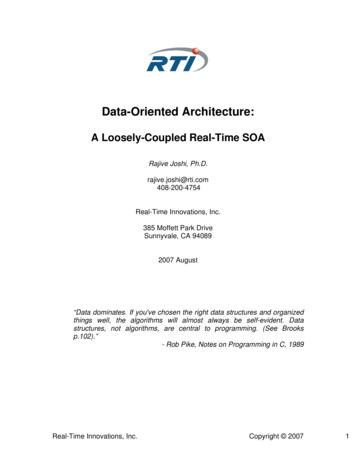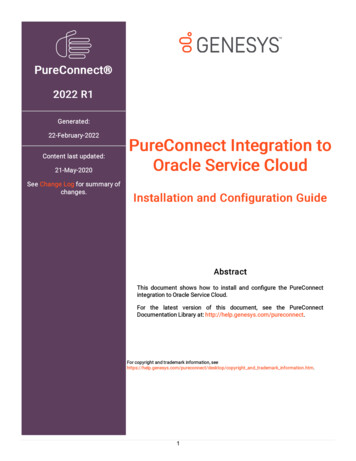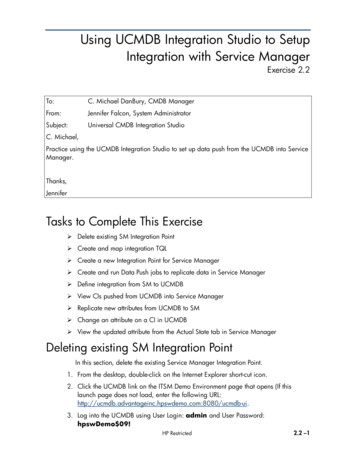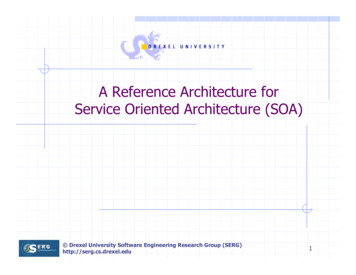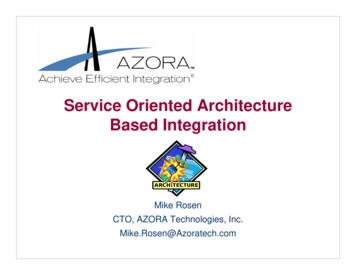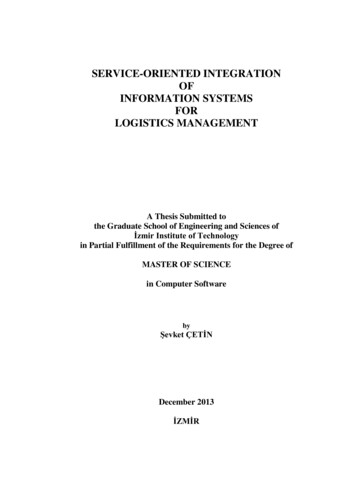
Transcription
SERVICE-ORIENTED INTEGRATIONOFINFORMATION SYSTEMSFORLOGISTICS MANAGEMENTA Thesis Submitted tothe Graduate School of Engineering and Sciences ofİzmir Institute of Technologyin Partial Fulfillment of the Requirements for the Degree ofMASTER OF SCIENCEin Computer SoftwarebyŞevket ÇETİNDecember 2013İZMİR
We approve the thesis of Şevket ÇetinExamining Committee Members:Asst. Prof. Dr. Tolga AYAVDepartment of Computer Engineering, Izmir Institute of TechnologyAsst. Prof. Dr. Tuğkan TUĞLULARDepartment of Computer Engineering, Izmir Institute of TechnologyAsst. Prof. Dr. Derya BİRANTDepartment of Computer Engineering, Dokuz Eylül University5 December 2013Asst. Prof. Dr. Tolga AYAVSupervisor, Department of Computer EngineeringIzmir Institute of TechnologyProf. Dr. İ. Sıtkı AYTAÇHead of Department of ComputerEngineeringProf. Dr. R. Tuğrul SENGERDean of Graduate School ofEngineering and Sciences
ACKNOWLEDGEMENTForemost, I would like to express my sincere gratitude to my advisor Asst. Prof.Dr. Tuğkan TUĞLULAR for the continuous support of my study and research, for hispatience, motivation, enthusiasm, and immense knowledge. His leadership helped me inall study and writing my thesis.I want to thank to manager of Bimar cooperation Murat ÖZEMRE for hissupport on thesis project.I wish to express my sincere thanks to my friend and project partner Dilek TİTİZfor his support and friendship during thesis work.Also I would like to thank to Asst. Prof. Dr. Tuğkan TUĞLULAR and BimarCooperation. With their help, this project case study work is submitted as a SANTEZproject with project number 00933-STZ.2011-1.I also want to thank to developers of Bimar; Murat FERUZ, Engin GÜRAY,Kerim ÖNDER and Uğur DOĞAN for their helps about technical details during thesisstudy.
ABSTRACTSERVICE-ORIENTED INTEGRATION OFINFORMATION SYSTEMS FOR LOGISTICSMANAGEMENTDevelopments in information technology have become more crucial forcorporate firms and businesses. They make use of this technology to manage businessprocesses and it is one of the most invested domains by corporations. As technicalinfrastructures of companies improve, the number of enterprise-oriented and specialsoftware developed for business processes increase, too. With the augmentation ofcooperation between companies and incorporated business processes, in time, a need forintegration emerges for the applications running in diverse infrastructures andtechnologies.Logistics business processes are a part of a business domain where there aremultiple areas of study such as railway, seaway, road transportation and depot, andwhere multiple companies and a high number of customer needs are managed.Integrations between companies should be quick, reliable, easily-adaptable to changingbusiness processes is a crucial requirement. As integrations play a significant role in themanagement of process, the correct establishment of the integration architecture,convenience for follow-ups and management are critical for the flow of businessprocesses related to the monitoring of the possible problems.The main point of this thesis is based on a need for a software infrastructure thatwill enable integrations to work together. Thus, by getting integrations to utilizeservice-based architecture, to react quickly to changing business processes and customerneeds, it is aimed to provide management and for exception monitoring. That’s why Ifocused on integration of service-based information systems for logistics managementin my thesis.iv
ÖZETLOJİSTİK YÖNETİMİ İÇİN SERVİS TABANLIBİLGİ SİSTEMLERİ ENTEGRASYONUSon yıllarda bilgi teknolojilerinin gelişmesi, kurumsal firmalar ve işletmelerin işsüreçlerinin yönetebilmek için kullandıkları ve yatırım yaptıkları alanlardan birisidir.Şirketlerin teknik altyapılarını geliştirmesiyle birlikte, iş süreçlerine özel yazılımlar,kurumlarınaa yönelik geliştirilen uygulamaların sayısı artmaktadır. Kurumlar veişletmelerin birbirleriyle ilişkileri ve birleştirilen iş süreçleri nedeniyle farklı altyapı veteknolojilerdeki bu uygulamaların entegrasyonu ihtiyacı ortaya çıkmaktadır.Lojistik iş süreçleri de kara, deniz, hava, demir yolu, depo gibi fazla sayıdaçalışma alanı içeren, farklı firma ve fazla sayıda müşteri taleplerinin yönetildiği bir işalanıdır. İş süreçlerinin kompleks, birlikte çalışılan firma ve kurum sayısının çok olmasısebebiyle entegrasyonu yapılacak uygulamarın sayısı da oldukça fazladır. Buentegrasyonların hızlı, güvenilir, değişen iş süreçlerine çabuk adapte olması ise kritikbir gereksinimdir. Sürecin yönetilmesinde entegrasyonların rolü büyük olduğundan,entegrasyon mimarisinin doğru kurulması, izleme ve yönetimin rahat yapılabilmesi,oluşabilecek hataların takibi iş akışlarının düzenli olarak çalışması açısından kritiktir.Tez kapsamını da lojistik iş süreçleri için entegrasyonların birlikte çalışmasınısağlayan bir yazılım altyapı gereksinimi tezin ana oluşturmuştur. Bu sayedeentegrasyonları servis tabanlı mimari'nin avantajlarından faydalanmış, değişen işsüreçlerine ve müşteri taleplerine hızlı cevap verme, entegrasyonların yönetimi ve süreçiçinde yaşanan hataların takibi için gerekli çözümü sağlayacaktır. Bu sebeple lojistikyönetimi için bilgi sistemlerinin servis tabanlı entegrasyonu bu tezin konusunuoluşturmaktadır.v
TABLE OF CONTENTSLIST OF FIGURES .xLIST OF TABLES . xiiCHAPTER 1. INTRODUCTION .1CHAPTER 2. REVIEW OF LITERATURE .4CHAPTER 3. BACKGROUND 83.1. Enterprise Application Integration . 83.1.1. Reasons for Integration of Information Systems .93.1.2. Enterprise Integration Challenges . 103.1.3. Benefits of Enterprise Application Integration .113.1.4. Types of Enterprise Application Integration . 123.1.4.1. File Transfer . 123.1.4.2. Shared Database .143.1.4.3. Remote Procedure Invocation . 163.1.4.4. Messaging 173.1.5. Topologies of Enterprise Application Integration .183.1.5.1. Point to Point Topology .183.1.5.2. Hub and Spoke Topology .203.1.5.3. Bus Topology . 213.2. Enterprise Service Bus .223.3. Software Products For Enterprise Application Integration 253.3.1. BizTalk Server .263.3.2. Enterprise Service Bus Toolkit .283.4. Container Logistics Business Process . 32CHAPTER 4. METHODOLOGY .34CHAPTER 5. PROPOSED SERVICE ORIENTED INTEGRATION OFvi
LOGISTICS INFORMATION SYSTEMS .41CHAPTER 6. CASE STUDY in BİMAR .486.1. Service Oriented Integration Framework with ESB Toolkit 506.2. Service Oriented Integration of Logistic Processes.536.3. Integration Management in SOA based ESB Framework 55CHAPTER 7. CONCLUSION .58CHAPTER 8. FUTURE WORK .60REFERENCES .61APPENDIX A. BUSINESS PROCESSES ANALYSIS .64vii
LIST OF FIGURESFigurePageFigure 3.1. Enterprise Integration Systems .9Figure 3.2. Integration by File Transfer 13Figure 3.3. Integration by Shared Database .15Figure 3.4. Integration by Remote Procedure Invocation .16Figure 3.5. Integration by Messaging .17Figure 3.6. Point to Point Topology .19Figure 3.7. Hub and Spoke Topology .20Figure 3.8. Bus Topology .22Figure 3.9. Overview of Enterprise Service Bus .24Figure 3.10. BizTalk .26Figure 3.11.BizTalk Server Architecture .27Figure 3.12. Microsoft ESB Toolkit .29Figure 3.13. ESB Toolkit Architecture .30Figure 3.14. ESB Toolkit Sample Message Flow .32Figure 3.15. Container Logistics Business Process .33Figure 3.16. Container group For Arkas Logistics .33Figure 4.1. Containers Logistic Depot Business Process Analysis .36Figure 4.2. File groups between Depot, Agency and Port 37Figure 4.3. Integration Point between Depot and Agency 38Figure 4.4. SOA Based Integration Infrastructure 39Figure 5.1. Hub and Spoke Architecture Diagram 42Figure 5.2. BizTalk integration with static configuration .43Figure 5.3. Enterprise Service Bus Toolkit .43Figure 5.4. Itinerary design and service list .44Figure 5.5. Service Definition in ESB.Config .45Figure 5.6. Dynamic Configuration in Business Rule Engine .46Figure 5.7. Dynamic Resolution with Resolver Framework .47Figure 5.8. Classic vs. Proposed Integration Solution .47Figure 6.1. ESB Toolkit infrastructure with custom framework .49viii
Figure 6.2. SOA based ESB Services .51Figure 6.3. SOA based ESB Toolkit framework .53Figure 6.4. Container logistics integration list .55Figure 6.5. Integration and exception tracking .57ix
LIST OF TABLESTablePageTable 6.1. Integration to work with custom framework .54Table 6.2. List of merged integrations .55Table 6.3. BizTalk vs. SOA based framework comparison .57x
CHAPTER 1INTRODUCTIONIn today’s world, it has been an ordinary fact that all enterprises around theworld cooperate with each other. This has become a necessity for them to grow, to besuccessful in the market, thus to increase their profits.With the increasing number of companies working together, that the processesrun in cooperation plays a much more important role because with cooperation andpartnership, a flexible action area and more advantages for the company are obtained.That’s why management departments in companies aim to increase the number ofproviders and the enterprises that they will cooperate with in order to get a widerbusiness network.Integration between companies plays an important role for healthy processescarried out in cooperation and for the companies to communicate with each other.Considering this, to achieve cooperability of different software used in a singleenterprise, dozens of integrations need to be defined and managed. This is only possiblewith an integration infrastructure that can provide an optimum solution and adapt todifferent technological infrastructures of the enterprises.Amongst each other, integration architectures can work in different topologiesaccording to their diverse working principles and architectures. In this study, the aim isto use message-based integration architecture which will provide the optimum solution.The focal point of this study is a Service-based Integration Infrastructure forinformation systems of the logistics processes where there is multiple companies worktogether and business processes are complicated. This joint study by Izmir Institute ofTechnology, by Arkas which is a logistics company and by Bimar managing the ITprocesses of Arkas has been accepted as a Sanayi Tezleri Programı (SAN-TEZ) project.With this study, an integration infrastructure that will enable cooperation with logisticsbusiness processes aims a Business Activity Framework allowing the management ofbusiness data.With this architecture, shared business processes that Arkas Company, which isin the container logistics sector, carries out with other enterprises and providers will be1
co-operable and monitorable. Thus, their cooperation level which now cannot beimproved due to this technological infrastructural short-coming will increase and thesector will be more efficient and more dynamic.Container Logistics Sector manages transportation activities in many mods(seaway, road, railway, air, depot, port, etc.). Since the number of shipping areas andoptions is high, the number of cooperating enterprises and providers is also supreme. Ashipment or transportation action is realized as a business process to which more thanone enterprise contributes. In order for business processes to run healthily, integrationshould be manageable and monitorable.However, high number of integrations is one of the crucial parameters for thesolution of the problem because the integrations examined in the study work as differentintegrations although they represent the same processes and use similar data. Thissituation increases the cost both during the development and the following maintenanceand support processes of the integrations. Furthermore, increasing number ofintegrations affect customer satisfaction with regards to follow-ups and maintenanceproblems.With the integration infrastructure developed in this study, the problemsaforementioned and the exceptions ensuring these problems will be monitorable from asingle point. It will easier to detect and to deal with the occurring problems and alsomore convenient to determine which problems are critical. Thus, this study aims toprovide a solution to the relating problems with an architecture that will enableenterprises to communicate with each other during these processes. The main approachused to create this architecture was Enterprise Service Bus architecture (ESB) whichsupports Message Based Middleware and Service Oriented Architecture (SOA) features.SOA architecture is an approach where logic and infrastructure resources are organizedas services for business processes and accessed through mutual message exchange. Byutilizing SOA properties with this architecture, the aim is to provide integration ofcomplex business processes with reusable services. The route to solution is throughintegration services developed as agile, flexible and quick to respond changing businessflows and customer needs.For the services targeted within the scope of the study, a Microsoft product,BizTalk integration server and ESB Toolkit which is released for ESB architecturesupport will be used. Although BizTalk integration server used in Bimar Company ismessage-based as the working principle, it cannot make use of SOA architecture2
properties. The increasing number of integrations, changing business processes andintegrations needed to be developed enhances the complexity of the present system.This increasing complexity costs more time and money to companies and complicatesthe solutions to the occurring problems.In the thesis, the aim is to provide a service-based integration of logisticsinformation systems through analyses of container logistics processes, data modelingand through a software infrastructure which the integration can cooperate with. Theadvantages provided with this study are the following. Realization of integrations in a service-oriented architecture. Reduction in the number of present integrations and providing a reusableinfrastructure for new integrations. Reduction in time spent on development and maintenance Providing a service infrastructure for the follow-up of integrations and theproblems arisen in the business processes. Providing an integration which is more agile for changing business processesand customer needs.3
CHAPTER 2REVIEW OF LITERATUREThe rise of cooperation between companies and enterprises that developinformation technologies infrastructure has brought about a need for communication forthe applications that work in different infrastructures. With the increasing number ofdiverse applications, a lot of efforts have been put into to improve communication andcooperation atmosphere, to reduce management costs and to optimize all processes.Research on these topics is outlined below.The study which was explained in the article An Integration Research onService-oriented Architecture (SQA) for Logistics Information System by LuyangZhang, Jiaqi Li, Ming Yu focuses on the management of container logistics businessprocesses with ESB that supports a SOA-based architecture. Here they determined thatthis was the most effective methodology for the integration solutions of service-basedarchitectures. Container logistics business processes have a huge area of business andwithin themselves they contain diverse enterprise applications and business processes.That’s why, he mentions about an emerging need for the applications from differentplatforms to work in an integrated way. In this integration architecture, thismethodology was used for ESB application: each running present application isintegrated to the system as one web-service, as applications added as we-services canoperate on their own, they obtain a reusable property and can adapt more to changingbusiness processes. Not a single application will directly communicate with another,but the integrations will be realized on ESB backbone. In this solution offer, up to 60%reduction in development costs is reported thanks to ESB architecture and service usage[25].In their article Research and Application of the ESB Based on Agent in theIntegration of the MIS in Power Plant, Fei and Shufen propose to use ESB and SOAarchitecture in management information systems of power plants for example. In thesemanagement systems, system integration is targeted by forming a ESB backbone for thedomain which consist of a financial system, a human resources management system, a4
production management system, a scheduling management system, material andequipment management systems [26].Furthermore in this system integration, first of all, present systems aredetermined as services and are included in the system. Through a different approach,systems that should be integrated with each other can work under sub-ESBs by utilizingmore ESB structure. In this way, applications running only under its sub-ESBarchitecture check the incoming requests in sub-ESB for the first time and sends them torequest agent ESB to find the responsive service if the response does not returns. AnESB structure that supports SOA architecture can also be used for different purposese.g. for common platforms in schools as explained in the article Research onapplication of Web based ESB in School Common Data Platform. The usage of webservices are realized within ESB, data interchange between different departments areprovided on Web Services Description Language (WSDL). Heterogeneous systems thatare outside the school applications are adapted to ESB with adapters which need to bedeveloped. As various protocols are supported, adapters to be implemented can also beused in different protocols. In this study, integration or data resemblance is not checked,yet each of end-point is included in the system as an integration point [27].One of the methods for the management of business process solutions andmanagement of integrations is explained in this study by Rajini and Bhuvaneswair. Asexplained in Service Based Architecture for Manufacturing Sector, architecture wasdesigned consisting of five layers and each layer manages a part of the process:Presentation Layer where other layers put user products and services into the system,Business Process Layer which manages business processes where all enterprises orapplications connect to the system, Business Service Layer which connects businessprocesses with integration layer, Integration Layer which handles service integration,routing and transformation processes; and Data Layer where data used by the servicesare stored and where physical resources that can be accessed on the Internet are located.With this architecture, the aim was to resolve process integrations with service-basedarchitecture, However, there is not a systems present to deal with exception orintegration monitoring [28].Operating Enterprise Application Integration with Enterprise Service Bus wasstudied in Research of Enterprise Application Integration (EAI) Based-on ESB by Tao,and Wu. The article explains that applications under EAI-ESB approach communicatewith each other through an architecture consisting of eight steps. These steps are:5
Message construction, Messaging channels, Listener, Decryptor, Validator, Enricher,Transformer and Router. Moreover, here it is explained that exceptions have twodifferent exception handling strategies: First strategy is the exception handlingoccurring in the connection points of the end-points. Second one is the exceptionhandling on the basis of applications which components, namely, business processeswork with. Exception framework and service which I applied in my thesis, enables theuse of exception handling infrastructure for both strategies [29].Container logistics business processes can be analyzed in a way to be able towork in SOA architecture, as it was done in the study by Wolfgang Seiringer. In hisarticle Service-oriented Analysis of Logistics Services, and the attempts to explain withwhich methods business processes are defined as services. There two service definitionsaccording to study, first of which is Web-Service standard WDSL and second onedefine service from three points of view: Service value independent of technology,service offering and service process. In the service analysis of container logisticsdomain, the methodology how to determine the similarities between the entities that aredefined as service value was explained. This methodology involves two steps: firstbeing the determining and analysis of the present services and the second one beingentity similarity study and service modeling [30].The concept of agility has also been influential in determining dynamic routingprocesses. Yo and Yan, in their article, Towards the Integration of Enterprise ServiceBus with Universal Description Discovery and Integration (UDDI) Server: A CaseStudy suggest that the agility concept which ESB benefits from the advantages of SOAarchitecture can be developed to enable dynamic and in run-time routing for the routingprocess within the architecture. In this methodology, business processes are managed inBusiness Layer, and there is a UDDI server in the integration layer. ESB uses UDDIserver for message routing. In this way, with proxy server, ESB sends a request toUDDI server for message routing it receives and incoming request includes the addressto which the message leads. Thus, this enables an agile infrastructure in rum-time,providing dynamic routing. In our study, UDDI infrastructure is present in ESB.However, in the case study of Bimar, we used Business Rule Engine infrastructure fordynamic routing [31].When the studies conducted are examined, it is seen that a solution is targetedfor the integration of applications and the management process of these applications.For solving the diverse business flows and related problems, service-based architecture6
use is suggested. In other studies parallel with this thesis, integrations are aimed throughreusable services, and Enterprise Service Bus architecture are used in different ways toprovide solutions to the problems. In order to provide a quick solution to monitorabilityand possible problems, exception handling is engaged in ESB architecture. Like thestudies carried out before, in this study, utilizing the SOA advantages, an effectivesolution is targeted on ESB architecture, furthermore, launching a product which willprovide follow-up and control with regards to service and business flows is aimed.7
CHAPTER 3BACKGROUND3.1. Enterprise Application IntegrationEnterprise Application Integration (EAI) enables various software systems orapplications to intercommunicate. Furthermore, subsystems are put together with thehelp of enterprise application integration, and they act as a single system. Thus they areable to function as a coordinated, whole body. These applications may be available outin the market for private usage, or they might as well be developed by the companyitself.The concept of integration of enterprise application is the direct result of thecommunication challenge that enterprises or companies needed to intercommunicate.The communication in question does have to be directed towards a business goal and ithas to be attained regardless of temporal and special features of the applications as itwasnicely put by Samtani and Sadhwani as “the process of creating an integratedinfrastructure linking disparate systems, applications, and data sources within acorporate enterprise” [1].EAI is a six step process: The first step is the receiving the message, then thismessage is altered, and translated. The fourth step is the routing of the message.Directing of the message to the desired spot and business process management are thelast two steps. The temporal process of the delivery of the messages is dependent on thebusinesses.8
Figure 3.1. Enterprise Integration Systems3.1.1. Reasons for Integration of Information SystemsWith the advent of computationalization and with the structural challengesfaced, organizations have depended on information systems, these organizations, intime, came up with particular individual systems, which meant that these systems werebound to be different from one another [2].At first, ERP (enterprise resource planning) vendors succeeded in providingextensive business applications, yet with the rise of technology, the number ofsupplier/vendor companies and the number of companies that were involved in in-housedevelopment has risen, and naturally along with these, so has the number of the systemsthat have been developed by these companies, thus making these systems insufficientthereby creating a need for integration.These systems in question include a number of applications which arecustomized according to the purpose they serve for and are designed to operate invarious operating system platforms or media. Yet, these systems are formed in a waythat they can only address to the particular tasks in a particular area. Hence in timefocusing on their functionality has culminated in the creation of “islands ofapplications”, disconnecting the systems from each other as Sawhney explains [3].9
It is essential that these applications should be integrated with each other andthis is only possible with supporting common business processes and data sharingamongst the applications. However, the integration has to sustain an effective, safe dataexchange between applications used by the enterprises. With the integration of thesesystems, the integration that is possible between other service providers and the clientshas the potential to bring about a wider area of actions and the advantage of competitionfor the companies [4]. Focal point in this thesis, container logistic information systems,is a perfect example for distributed applications and different platforms. Differentbusiness processes have to be in operation all together and supplier company systems,other in-house services or major billing systems like SAP need to be present in businessprocesses. These two factors require integrity of reliable and stable integrations.3.1.2. Enterprise Integration ChallengesIt is a strenuous task to integrate enterprise applications and distributed systemsbecause these systems are seen as a very valuable investment both financially and withregard to the amount of data they contain for the company, hence, making it almostimpossible to alter them with newer systems [5].Enterprise integration has to be constructed in a way that can handle numerousapplications operating on various platforms in various places. Enterprise applicationintegration suites are provided by software vendors and these suites enable integrationbetween different languages and platforms, and connect to numerous businessapplications. Nevertheless, the technical base renders only a small amount of thechallenges faced in the integration process which goes beyond corporate and technicalissues.Corporations are usually required to alter their policies when it comes toenterprise integration. Corporate applications are usually concentrated on a particularfunctional realm. Customer Relationship Management (CRM), Billing, Finance orLogistic Information Systems that is the focal point of my thesis are main examples.Effective enterprise integration is possible only with intercommunication betweennumerous computer systems and also with communication created between businessunits and IT departments. Applications are not controlled one by one by integration10
application groups since each and every application becomes a member of a body of anintegrated applications and services.An application might have a wide range of functionality i.e. a payment systemapplication, thus it needs to provide an interface enabling communication between allvendors also to fulfill customer needs, yet integration brings about extensiveramifications on the businesses. When an integration solution is adopted into one of themost important business processes like payment system functions, solution affectsprogress of the whole business. A failure in an integration solution may lead to lostorders, misrouted payments as most importantly customer dissatisfaction, thus costingbusinesses millions of dollars.When developing integration solutions, developers generally face numerouschallenges one of which is their limited control on the applications that participate in thesystem. Some of those applications might be packaged or may just be used for a longtime and hard to alter, which makes them very hard to adapt to an integration solution.Yet it is often easier to implement a part of the solution within the applicationnevertheless it is very probable that all integration objectives, especially ones that arevery hard to adapt to applications, might not be reached. As the systems improve andnew platforms, services and applications emerge in the market, the number ofincompatible areas or points in the integration process will continue to increase, thusmaking it impossible to change all the failed points in the integration process and tomake them compatible again.Although there is a huge demand for integration solutions, only a handful ofstandards are seen as legitimate in the domain. XML, XSL and Web services can bedemonstrated as the most advanced steps towards standardized features for integrations
used to create this architecture was Enterprise Service Bus architecture (ESB) which supports Message Based Middleware and Service Oriented Architecture (SOA) features. SOA architecture is an approach where logic and infrastructure resources are organized
